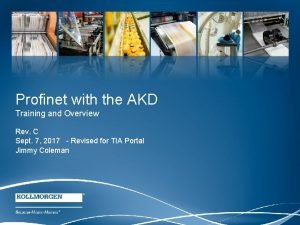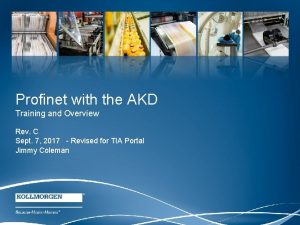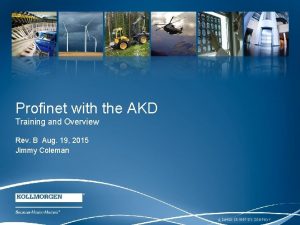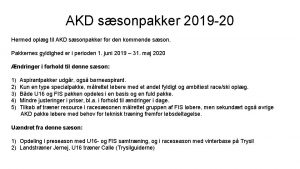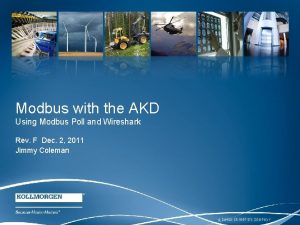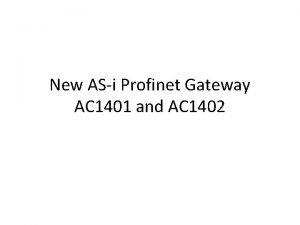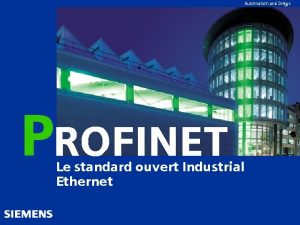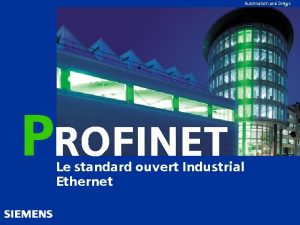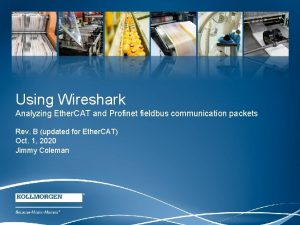Profinet with the AKD Training and Overview with
















- Slides: 16

Profinet with the AKD Training and Overview, with Siemens TIA Portal Rev. D May 10, 2018 Jimmy Coleman 1

Reference Sources Profinet Documentation Manual – AKD Profinet Communications Manual – AKD Profinet Sample Project Manual KDN Articles Software Simatic Step 7 TIA Portal V 13, V 14, and V 15 2 2

Profinet Communication Settings Port: Profinet communication on the AKD drive is handled through the Service Port. That is the X 11 Ethernet port that is use for communication with the Workbench software. Workbench uses ASCII commands over Telnet communication. It is possible to communicate via Profinet and Telnet at the same time from the same PC. TCP/IP: The AKD is identified over Profinet communication by the IP address of the drive and the name of the drive (the drive name in Workbench). Firmware: This document is based on firmware version 1 -16 -00 -002. 3 3

Profinet Baud Rate Settings: • Automatic • 16 ms (from GSDML file) Set the baud rate to “Automatic” for best results. The GSDML file sets the baud rate to 16 ms. You can set the baud rate to 16 ms with a “Fixed update time”, but if you do, the PLC will not reconnect to the drive after the drive is power cycled. If the baud rate is set any faster than 16 ms (shorter time), then the communication buffer will fill up and the drive will fault. 4 4

AKD Command Source with Profinet When the AKD drive is in Position Mode, the command source will be “Service”. When the drive is in Velocity Mode, the command source will be “Fieldbus”. • • Service for Position mode (Telegrams 7, 9, 352, 353, and 400) Fieldbus for Velocity mode (Telegrams 1, 350, and 351) The command source is based on where the actual motion command is generated. With the AKD in position mode and running motion tasks, the motion command is coming from the Command Generator in the drive. The PLC sends the values for the motion task, but the incremental/instantaneous command is from the drive itself. In velocity mode, the motion command is coming directly from the PLC. The command source will be set automatically based on the telegram that is being used. The operation mode must be set either in Workbench (DRV. OPMODE) or by using the “Parameter Access” channel from the PLC (PNU 930). The operation mode will not automatically be set based on the telegram selection. 5 5

Telegrams The Profinet communication protocol uses a telegram consisting of up to 12 words (16 bits each) for command setpoints and 12 words (16 bits each) for status. Velocity Mode: • Standard Telegram 1 • Manufacturer Specific Telegrams 350 and 351 Position Mode: • Standard Telegram 7 and 9 • Manufacturer Specific Telegrams 352 and 353 • Free-mappable Telegram 400 The position commands are sent to Motion Task 0 in the AKD. The telegram is specified in the PLC hardware configuration. When communication is established between the PLC and the AKD drive, the PLC sets the telegram number in the AKD. You can read the telegram number that has been configured by the PLC in FBUS. PARAM 01. Even though this is not a read-only parameter, setting the value of this parameter will not configure the telegram number. It should be treated as read-only. The telegram number can be changed by the PLC program using PNU 922 (in the Parameter Access channel). 6 Each telegram contains the Control Word and the Status Word. Profinet uses a State Machine as described in the manual. 6

Control Word (STW 1) As a quick start, the bits of the Control Word should be used in the following sequence for enabling the drive and starting motion. As each bit is turned on or off, the other bits must be maintained in their current state. Turn on bit 10 (allow PLC control), then turn on bit 1(coast stop function), then turn on bits 2, 4, and 5 (stop and pause functions) in any order, then turn on bit 0 (ready for enable), then turn on bit 3 (enable), then use either bit 6, 8, 9, or 11 (depending on the desired function) to start motion. Sequence to enable: • Turn on bit 10 • Turn on bit 1 • Turn on bits 2, 4, and 5 in any order • Then turn on bit 0 • Turn on bit 3 7 7

Free Mapping a Telegram Use Telegram 400 for free mapping. The manual says to use Telegram 0, but 400 is better. TG 400 is similar to TG 0, but it defines the data size more appropriately. TG 400 has available 12 words (16 bits each) for commands and 12 words (16 bits each) for status. The telegram is mapped using PNU 915 for the command words and PNU 916 for the status words. Each subindex of these PNU’s correspond to the order of the data in the telegram. The value that is used to map specific data to each word is called a signal number. The available signal numbers are listed in the manual. You can free-map a telegram with any data that has a Signal number. Default mapping for Telegram 400: PNU 915 for the commands and setpoints: For Word 1, Write PNU 915 subindex 0 = 1 (for STW 1) For Word 2, Write PNU 915 subindex 1 = 32 (for SATSANW) For Word 3, Write PNU 915 subindex 2 = 3 (for STW 2) For Word 4, Write PNU 915 subindex 3 = 34 (for MDI_TARPOS) For Word 5, (this will automatically be the lower 16 bits of MDI_TARPOS) For Word 6, Write PNU 915 subindex 4 = (for MDI_VELOCITY) For Word 7, (this will automatically be the lower 16 bits of MDI_VELOCITY) For Word 8, Write PNU 915 subindex 5 = 36 (for MDI_ACC) For Word 9, Write PNU 915 subindex 6 = 37 (for MDI_DEC) For Word 10, Write PNU 915 subindex 7 = 38 (for MDI_MOD) Add more by writing to the next subindex. PNU 916 for the status and actual values: For Word 1, Write PNU 916 subindex 0 = 2 (for ZSW 1) For Word 2, Write PNU 916 subindex 1 = 33 (for AKTSATZ) For Word 3, Write PNU 916 subindex 2 = 4 (for ZSW 2) For Word 4, Write PNU 916 subindex 3 = 28 (for XIST_A, PL. FB) For Word 5, (this will automatically be the lower 16 bits of PL. FB) Add more by writing to the next subindex. 8 8

PN. DIAG The parameter PN. DIAG will output some useful Profinet information in the Workbench Terminal screen. It shows the last acyclic data transmission and the mapping of the current telegram. Once the Telegram 400 mapping has been written, it can be checked using the parameter PN. DIAG in the Workbench Terminal screen. The mapping data lists the signal numbers in the order of the telegram words. Keep in mind that some data has the size Double Word, and will therefore take two consecutive words in the telegram. 9 9

User Units over Profinet Position Scaling: PNU# 1002 sets the number of bits per motor rev. Default is 16 for 2^16 counts per rev. Example Command Values in Telegrams 9, 352, 353, and 400: Velocity Scaling: 2^15 = 100% of maximum speed, which is 12, 000 rpm for the AKD. So 2^15 = 12, 000 rpm STW 1: Turn on bits: 10, 1 and 2, 0, 3 (enable), 4 and 5, 6 (start motion) Velocity Mode: (Profinet Velocity) = (Speed in rpm) * 2^15 / 12000 (Speed in rpm) = (Profinet Velocity) * 12000 / 2^15 MDI_VELOCITY = DW#16#02222222 = 100 rpm Position Mode: MDI_Velocity = (Speed in rpm) * 2^32 / 12000 Speed in rpm = (MDI_Velocity) * 12000 / 2^32 SATZANW 1: motion task #. 0 x 8000 uses MDI move profile data MDI_TARPOS = DW#16#00010000 = 10000 hex = 65536 counts = 1 rev MDI_ACC = W#16#03 E 8 = 763 krpm/s (rounded to 763, 088. 448 rpm/s) MDI_DEC = W#16#03 E 8 = 763 krpm/s MDI_MOD: 1 = absolute move; 0 = relative move; (MDI profile only) MT. CNTL Bits 10 and 11 have been added in FW 1 -13 beta for control of S-curve acceleration profile. MDI_ACC = accel in rpm/s * 2^16 / 50, 000 Accel in rpm/s = MDI_ACC * 50, 000 / 2^16 Same for MDI_DEC. Accel and decel in the drive will be in increments of about 763 rpm/s. 10 10

Parameter Access Channel – Read Parameter Request (from PLC to drive) Byte Data Size Allowable Values Typical Value 0 Request Reference Description Unsigned 8 bit 0 x 00 is reserved; 0 x 01 - 0 x. FF Defined by PLC 1 Request ID Unsigned 8 bit 0 x 01 Read Always 0 x 01 2 Axis # Unsigned 8 bit 0 x 00 only (AKD Parameter Manager) Always 0 x 00 3 No. of Parameters Unsigned 8 bit 0 x 01 - 0 x 27 0 x 01 4 Attribute Unsigned 8 bit 0 x 00 reserved; 0 x 10 Value; 0 x 20 Description Always 0 x 10 5 No. of Elements Unsigned 8 bit 0 x 01 - 0 x. EA 0 x 01 6 PNU Number - upper 8 bits Unsigned 8 bit 0 x 01 - 0 x. FF PNU 7 PNU Number - lower 8 bits Unsigned 8 bit 0 x 01 - 0 x. FF PNU 8 Subindex - upper 8 bits Unsigned 8 bit 0 x 00 only Always 0 x 00 9 Subindex - lower 8 bits Unsigned 8 bit 0 x 00 only Always 0 x 00 Data Size Allowable Values Typical Value 0 Request Reference Unsigned 8 bit 0 x 00 is reserved; 0 x 01 - 0 x. FF 1 Response ID Unsigned 8 bit 0 x 01 Read successful or 0 x 81 Unsuccessfull 0 x 01 2 Axis # Unsigned 8 bit 0 x 00 only (AKD Parameter Manager) Always 0 x 00 3 No. of Parameters Unsigned 8 bit 0 x 01 - 0 x 27 0 x 01 4 Attribute Unsigned 8 bit 0 x 00 reserved; 0 x 10 Value; 0 x 20 Description Always 0 x 10 5 No. of Elements Unsigned 8 bit 0 x 01 - 0 x. EA 0 x 01 6 PNU Number - upper 8 bits Unsigned 8 bit 0 x 01 - 0 x. FF PNU number 7 PNU Number - lower 8 bits Unsigned 8 bit 0 x 01 - 0 x. FF PNU number 8 Subindex - upper 8 bits Unsigned 8 bit 0 x 00 only Always 0 x 00 9 Subindex - lower 8 bits Unsigned 8 bit 0 x 00 only Always 0 x 00 10 Format Unsigned 8 bit 0 x 41 for byte; 0 x 42 for Word; 0 x 43 for Dword; 0 x 00 for no data 0 x 41, 0 x 42, or 0 x 43 11 Number of Values Unsigned 8 bit 0 x 01 12 Data - Most significant Signed 8 bit 0 x 01 - 0 x. FF Data 13 Data Unsigned 8 bit 0 x 01 - 0 x. FF Data 14 Data Unsigned 8 bit 0 x 01 - 0 x. FF Data 15 Data - Least significant Unsigned 8 bit 0 x 01 - 0 x. FF Data Read Parameter Response (from drive to PLC) Byte Description 11 11

Parameter Access Channel – Write Parameter Request (from PLC to drive) Byte Description Data Size Allowable Values Typical Value 0 Request Reference Unsigned 8 bit 0 x 00 is reserved; 0 x 01 - 0 x. FF Defined by PLC 1 Request ID Unsigned 8 bit 0 x 02 Write Always 0 x 01 2 Axis # Unsigned 8 bit 0 x 00 only (AKD Parameter Manager) Always 0 x 00 3 No. of Parameters Unsigned 8 bit 0 x 01 - 0 x 27 0 x 01 4 Attribute Unsigned 8 bit 0 x 00 reserved; 0 x 10 Value; 0 x 20 Description Always 0 x 10 5 No. of Elements Unsigned 8 bit 0 x 01 - 0 x. EA 0 x 01 6 PNU Number - upper 8 bits Unsigned 8 bit 0 x 01 - 0 x. FF PNU number 7 PNU Number - lower 8 bits Unsigned 8 bit 0 x 01 - 0 x. FF PNU number 8 Subindex - upper 8 bits Unsigned 8 bit 0 x 00 only Always 0 x 00 9 Subindex - lower 8 bits Unsigned 8 bit 0 x 00 only Always 0 x 00 10 Format Unsigned 8 bit 0 x 41 for byte; 0 x 42 for Word; 0 x 43 for Dword; 0 x 00 for no data 0 x 41, 0 x 42, or 0 x 43 11 Number of Values Unsigned 8 bit 0 x 01 12 Data - Most significant Signed 8 bit 0 x 01 - 0 x. FF Data 13 Data Unsigned 8 bit 0 x 01 - 0 x. FF Data 14 Data Unsigned 8 bit 0 x 01 - 0 x. FF Data 15 Data - Least significant Unsigned 8 bit 0 x 01 - 0 x. FF Data Size Allowable Values Typical Value 0 Request Reference Unsigned 8 bit 0 x 00 is reserved; 0 x 01 - 0 x. FF Defined by PLC 1 Response ID Unsigned 8 bit 0 x 02 Read successful or 0 x 82 Unsuccessfull 0 x 02 2 Axis # Unsigned 8 bit 0 x 00 only (AKD Parameter Manager) 0 x 00 3 No. of Parameters Unsigned 8 bit 0 x 01 - 0 x 27 0 x 01 10 Format Unsigned 8 bit 0 x 41 for byte; 0 x 42 for Word; 0 x 43 for Dword; 0 x 00 for no data 0 x 00 11 Number of Values Unsigned 8 bit 0 x 00 Write Parameter Response (from drive to PLC) Byte Description 12 12

PNU Data Size – “Format” Data Sizes in the Parameter Access Channel are referred to as the Format = data size of parameter (PNU) 0 x 41 = Byte 0 x 42 = Word 0 x 43 = Dword The number of bytes in a PNU read response or write request will vary depending on the Format. 0 x 41 = 1 byte 0 x 42 = 2 bytes 0 x 43 = 4 bytes The previous slides show 4 bytes of data being used, which would be for a PNU parameter with a size of Double Word (32 bits). For a Format of 0 x 42 (Word), the last two bytes (bytes 14 and 15) would not be used. 13 13

Profinet Commands in Workbench AKD Profinet commands can be used in the Workbench Terminal screen PN. STW 1 – reads the Control Word (STW 1) PN. ZSW 1 – reads the Status Word (ZSW 1) PN. POSSCALE – sets scaling for PNU data of position parameters (See the AKD Profinet Manual) PN. TIMEOUTFTHRESH – reads the time of an F 702 fault, based on time of Profinet master PN. DIAG – reads Profinet connection information, last acyclic transmission, and telegram mapping 14 14

Wireshark Filter for Profinet Display Filter Show only the PN-IO based traffic: • pn_io Show the PN-IO based traffic without the cyclic PN-IO telegrams (to avoid a lot of "noise"): • pn_io && !pn_io. ioxs 15 15

16 16
 Scada for dummies
Scada for dummies Hát kết hợp bộ gõ cơ thể
Hát kết hợp bộ gõ cơ thể Frameset trong html5
Frameset trong html5 Bổ thể
Bổ thể Tỉ lệ cơ thể trẻ em
Tỉ lệ cơ thể trẻ em Chó sói
Chó sói Tư thế worm breton là gì
Tư thế worm breton là gì Chúa yêu trần thế
Chúa yêu trần thế Môn thể thao bắt đầu bằng từ chạy
Môn thể thao bắt đầu bằng từ chạy Thế nào là hệ số cao nhất
Thế nào là hệ số cao nhất Các châu lục và đại dương trên thế giới
Các châu lục và đại dương trên thế giới Cong thức tính động năng
Cong thức tính động năng Trời xanh đây là của chúng ta thể thơ
Trời xanh đây là của chúng ta thể thơ Mật thư anh em như thể tay chân
Mật thư anh em như thể tay chân Phép trừ bù
Phép trừ bù Phản ứng thế ankan
Phản ứng thế ankan Các châu lục và đại dương trên thế giới
Các châu lục và đại dương trên thế giới

















